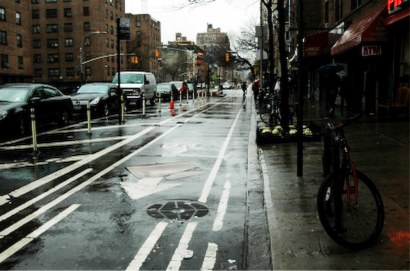Municipal leaders, advocates, and engineers in cities from Toronto to Tulsa, take note: The absurd debate about whether or not investing in bicycle-friendly streets is good for cyclists (and everyone else) is over. Done. Kaput. No longer deserving of a moment of your attention.
This debate has divided and distracted bicycle advocates for decades. I won’t give it any more air time here, and at any rate there is nothing new to say, but if you’re interested in exploring the one cycling topic more tediously and verbosely discussed than helmets, maybe start here.
For finally making the common sense of bike infrastructure in the US indisputable, we have the intrepid folks in New York City to thank. They have proven excellent in recent years at not only installing human-scale bike infrastructure, but quantifying its impacts.
In 2007, New York City added protected bike lanes, also known as “cycle tracks” to two previously car-centric one-way arterials in Manhattan, 8th and 9th Avenues. (This short movie explains more.) These lanes—basically, regular bike lanes with a physical barrier (often parked cars) and special signals at intersections in order to separate people on bikes from people driving and walking—were controversial before and after construction, with lots of dithering and yammering about how they would hurt business and freight, cause crashes, hold up traffic, and waste time and money.
The city’s transportation department released a study last October, however (I’ve been busy and just got in on the game this week), that puts much of that criticism to rest, with a zing. (Read about the study here or download the PDF here.)
First, on safety: True to form, this bike infrastructure did more than make cycling safer: The study found a 35% decrease in traffic crash related injuries to all street users on the 8th Ave path, and a whopping 58% on its 9th Ave counterpart.
Meanwhile, retail sales income in locally-based businesses along the 9th Ave lane went up as much as 50%. Yep, half again what they were before 2007. And this was during a recession. In the same period, borough-wide retail sales only increased 3%.
Protected bike lanes do cost money to install—with every penny furiously contested—but next to nothing compared to routine roadway maintenance and expansion projects. And instead of continuing to cost the community, they boost business, grow the tax base, and save money for the people who use them. And they even create smoother traffic flow for people who must still drive.
What’s not to love? No more debates, no more excuses. We cannot afford *not* to invest in safer, more profitable streets for cycling—and for everyone. And we likewise cannot afford to give a moment more of our energy to engaging or debating with so-called bicycle advocates who persist in fighting against improvements that are essential to our communities’ health, safety, and solvency.
The real debate should not be about whether or not to invest in bike infrastructure, but about how your city can create the most, the fastest.
It’s time for us to move on. If your city’s leaders don’t get this, it’s time for them to move on too.
PS: Here’s some more analysis from BikePortland.
Another note: I further make the economic case for bicycling in my forthcoming book, Bikenomics: How Bicycling Can Save the Economy (Dec 2013, Microcosm). I’ve also written extensively about this online and have an older zine on the topic available here.
